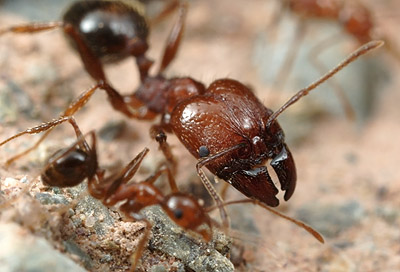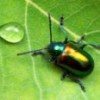A recent study by Gabriela Pirk in Insectes Sociaux provides me with an excuse to share this photo:

Minor workers of the seed harvester Pheidole spininodis (left) and the predatory Pheidole bergi lock jaws in combat. Jujuy, Argentina.
Pirk et al examined the diet of both Pheidole species in the Monte desert of Northern Argentina. Why would someone spend time doing this?  Ants are important dispersers of seeds, and these Pheidole are two of the most abundant seed-eating ants of the region. What they do with the seeds, which ones they choose to take, and how far they take them has implications for the ecology of the desert.
The interesting bit in my opinion is that the two ant species are rather different, both ecologically and biomechanically. Pheidole spininodis is a dedicated seed harvester. Their majors have enormous blocky heads with blunt mandibles for milling seeds:

Pheidole spininodis, major worker
In contrast, Pheidole bergi is primarily predatory, taking seeds only opportunistically. Their majors are slender, fast, and with relatively small heads and sharper mandibles better for slicing up the insects that they most commonly feed on:

Pheidole bergi, major & minor workers
- Log in to post comments

Ouch. Those mandibles on the majors of P. bergi really look like wire pliers. Just the right tool to cut insect legs. Very nice.
Hi Alex!
Great pics!
Next time you come to Argentina you should go and visit Ãacuñán's ants, what do you think?
All the best.
I really love natural history!